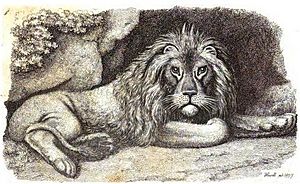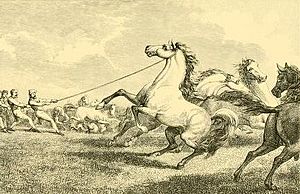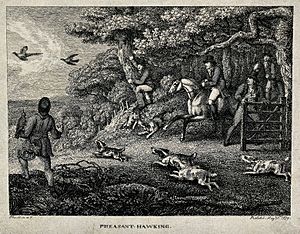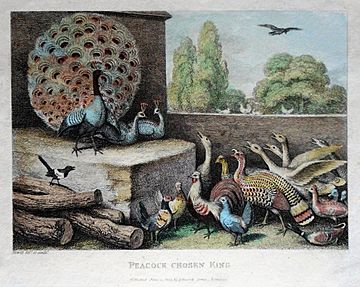Samuel Howitt facts for kids
Samuel Howitt (born around 1756 or 1757, died 1822) was a talented English artist. He was a painter, illustrator, and an etcher. An etcher creates pictures by scratching designs onto metal plates. Samuel Howitt was famous for his amazing drawings of animals, exciting hunting scenes, horse races, and beautiful landscapes. He used both oil paints and watercolors in his art.
Contents
How Samuel Howitt Lived and Worked
Samuel Howitt came from an old Nottinghamshire family who were Quakers. When he was younger, he lived in Chigwell, near Epping Forest in Essex. He had enough money and loved field sports like hunting. However, he later faced money problems. This meant he had to become a professional artist. Before this, he had only done art as a hobby.
Becoming a Professional Artist
Howitt moved to London. For a while, he taught drawing at a school in Ealing. In 1783, he showed three colored drawings of hunting scenes. He continued to show his art at different exhibitions. He displayed his first hunting picture at the Royal Academy in 1784. In 1785, he showed two landscape paintings. These were "A view of the ruins of an abbey" and "Fairlop Oak."
He also exhibited other works over the years. These included "Jaques and the Deer" (1793) and "A Fox Hunt" (1793). In 1794, he showed "Smugglers alarmed." Later, he displayed pictures of "Deer" (1800), "Dead game" (1814), and "Bella, horrida Bella" (1815). He probably didn't exhibit much because he was very busy. Many people wanted him to illustrate books and other works.
How Howitt Created His Art
Howitt mostly painted and drew sporting events and nature scenes. He made sure his drawings were very accurate and full of life. He said his animal drawings were "drawn from the life." This meant he drew them from real, living animals. He wanted his art to help other artists. He hoped it would guide those who couldn't study animals up close.
However, some of his animal studies were not from live animals. Notes in one of his sketchbooks show this. Some drawings of apes and monkeys were from private collections. But others were of stuffed animals. He studied these at William Bullock’s museum and the British Museum.
Howitt's Connections and Etchings
Samuel Howitt was good friends with another artist, Thomas Rowlandson. Howitt even married Rowlandson's sister. Because of this, sometimes Howitt's art was mistaken for Rowlandson's. But Howitt was different. He was a real sportsman himself. This made his scenes of sports more accurate and true to life.
Howitt was also a very skilled and hardworking etcher. He created many etched plates. These were similar to his drawings. He made them with a fine needle, creating delicate details. He also drew some funny pictures called caricatures. These were in the style of Rowlandson.
Famous Illustrations and Publications
Howitt was especially known for his illustrations in a book called Oriental Field Sports (1807). These drawings were based on sketches made in India. He illustrated many other books too. Some of these include:
- Thoughts on Hunting (1798)
- Miscellaneous Etchings of Animals (1803, 50 plates)
- British Field Sports (1807, 20 colored plates)
- The Angler's Manual (1808, 12 plates)
- A New Work of Animals (1811, 100 plates)
- Groups of Animals (1811, 24 plates)
- The British Sportsman (1812, 70 plates)
- Foreign Field Sports (1819, 110 plates)
Samuel Howitt passed away in 1822 in Somers Town, London. He was buried in St. Pancras cemetery.
A New Work of Animals
Samuel Howitt was very clever and good at business. You can see this in his book, A New Work of Animals. This book was a collection of copper engravings. Many of the pictures were inspired by the famous fables of Aesop, Gay, and Phaedrus.
The Idea Behind the Book
Howitt thought of creating an album of animal pictures. He wrote that it was "strange" that no British artist had done this before. He chose to show animals in fables. This allowed him to draw their expressions, personalities, and feelings better. He hoped his careful work would please natural historians. He also wanted to teach other painters.
Out of 100 pictures in the book, only 56 illustrated fables. The rest were of animals or hunting scenes.
How the Book Was Made
For the fables, Howitt used stories from Aesop and Phaedrus. He took them from a collection by Samuel Croxall. This included the long moral lessons that came with the fables. The fables by John Gay were in rhyme. They made up only 27 pages of the book's 106 pages of text.
The pictures were placed sideways in the book, opposite the titles. Some of these pictures were designed in 1809-1810. This was before the book was published in 1811. This suggests that the pictures might have been sold separately first. Fables often taught a moral lesson. This made them popular with more people than just sports fans. People could hang these pictures on their walls to learn from them.
These pictures were available in black and white, or with colors added. Howitt also made watercolors from these designs. He sold them with the moral printed on the card frame around the picture. This way, Howitt found three different ways to earn money from one set of artworks.
Later Editions and Legacy
A second edition of A New Work of Animals was published in 1818. Howitt's pictures were also printed again after he died. People continued to admire his work for many years. For example, six of his illustrations were used for a set of Mintons, Hollins tiles. These tiles showed Aesop's Fables and were first made in 1870. This was 60 years after Howitt's book came out! The tiles included famous fables like "The Tortoise and the Hare" and "The Bear and the Travellers."
|





